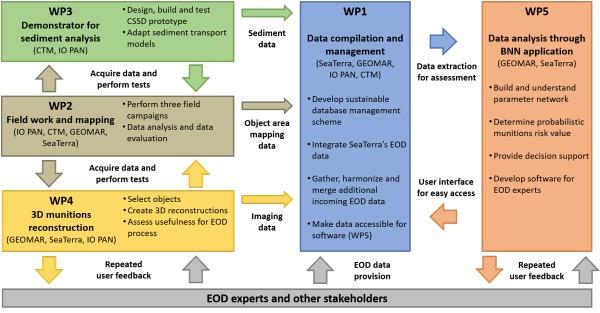The research project consists of six work packages (WPs). WP1 through WP5 cover the scientific and technical project work, while WP6 is an administrative WP.

Design of the ProBaNNt project visualizing the interconnections between WPs.
WP1: Data compilation and management
The basis for objective, structured, well-informed decision making is a well-managed explosive ordnance disposal (EOD) database, in which all available EOD data are converged and organized. These data need to include the information on the cleared munitions item but also information on the particular local environment and a clear rationale for the decision that led to a particular EOD method. Over the years, during which offshore EOD has taken place in Europe, thousands of these datasets have accumulated as a by-product of daily business. The aim of this WP, is to make these data readily available.
- Task 1.1: Set up of database hosting infrastructure
- Task 1.2: Collection and integration of EOD datasets
- Task 1.3: Development of a data management strategy
WP2: Fieldwork, technology application and detailed mapping
Field campaigns of the project will take place twice in Kolberger Heide (site A) in German waters and once in Gdansk Basin (site B) in Polish waters. The purpose of the fieldwork is to test technology solutions developed in WP3 and WP4 and to collect additional data as an input into the EOD database.
- Task 2.1: Execution of three field campaigns
- Task 2.2: Evaluation of all data acquired in field campaigns for scene recognition
- Task 2.3: Integration of all data acquired in field campaigns into EOD support tool

Map of the German and Polish Baltic Sea coast with field campaign sites.
WP3: Demonstrator development for in-situ sediment property analysis
Polluted sediments and their distribution pose an environmental hazard. Thus, spreading of such sediments during EOD should be avoided. To assess sediment mobility, an in-situ demonstrator will be developed. This critical shear stress device (CSSD) will generate progressive water currents while monitoring turbidity, to assess critical shear stress of sediments. This way the probability of sediment resuspension and mass of material that might be transported can be calculated. These results might exclude some EOD methods, eliminating those which could spread contaminated sediments to other areas.
- Task 3.1: CSSD conceptualization and product requirement documentation
- Task 3.2: CSSD construction
- Task 3.3: CSSD testing and calibration
- Task 3.4: Sediment transport model adaptation

Conceptual sketch of the CSSD (© IO PAN).
WP4: Optic and acoustic 3D munitions object reconstruction
EOD decision-making can be supported with computer-generated and correctly scaled 3D reconstructions of munitions objects, which can be rotated and jointly observed with other EOD specialists in the field or remotely on a computer. It is the goal to investigate, whether such 3D reconstructions are a useful addition to the EOD expert toolbox and a remotely supported decision-making processes.
- Task 4.1: Selection of exemplary munitions objects
- Task 4.2: Collection of data in the field
- Task 4.3: 3D reconstruction

Photogrammetric reconstruction of a British ground mine and its surroundings in the Kolberger Heide (© GEOMAR)
WP5: Data analysis through Bayesian Neural Network application
This WP deals with the generation of a holistic parameter network and its development into a Bayesian Neural Network in the time of the project. Input data will include the munitions items, EOD methods and the location-specific environmental conditions. The main input source for this network will be the information that is contained in the EOD database (WP1). Once the network is designed, case studies will be selected to test its ability to predict even probabilities, contributing factors and derive recommendations for EOD methods. A feedback process with industry experts will make sure that the network’s results are useful for the EOD process in practice.
- Task 5.1: Parameter identification and generation of network
- Task 5.2: Development and testing of the BNN
- Task 5.3: BNN application to EOD case studies
- Task 5.4: Integration of EOD support tool into the EOD process
- Task 5.5: Development of user-friendly EOD support software
WP6: Coordination & administration
This WP covers administrative and coordinative tasks.
- Task 6.1: Administration of the project and preparation of reports
- Task 6.2: Coordination of joined activities and control of timely execution
